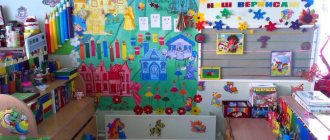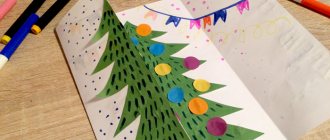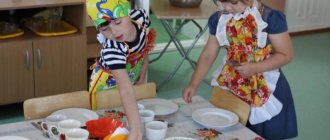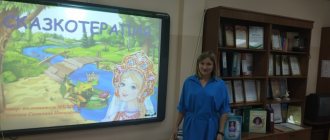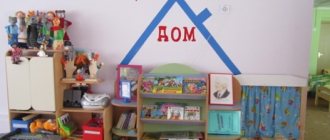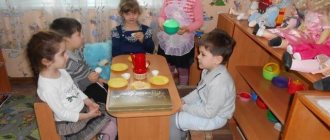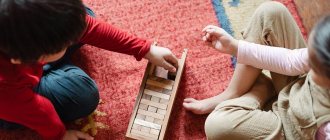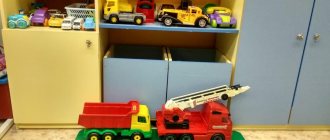Subject-based developmental environment as a means of developing oral speech in preschoolers.
Subject-based developmental environment as a means of developing oral speech in preschoolers.
The issue of organizing the subject-developmental environment of preschool educational institutions is particularly relevant today. This is due to the introduction of the new Federal State Educational Standard (FSES) to the structure of the basic general education program of preschool education.
In accordance with the Federal State Educational Standard, the program should be built taking into account the principle of integration of educational areas and in accordance with the age capabilities and characteristics of students. The solution of program educational tasks is provided not only in the joint activities of adults and children, but also in the independent activities of children, as well as during routine moments.
As you know, the main form of work with preschoolers and the leading activity for them is play. That is why practicing teachers are experiencing increased interest in updating the subject-development environment of preschool educational institutions.
The concept of a subject-developmental environment is defined as “a system of material objects of a child’s activity that functionally models the content of his spiritual and physical development”
(S.L. Novoselova).
Federal State Educational Standards requirements for a subject-development environment:
1. subject-development environment ensures maximum realization of educational potential.
2. accessibility of the environment, which implies:
2.1 accessibility for students to all premises of the organization where the educational process is carried out.
2.2. free access for pupils to games, toys, materials, aids, providing all basic activities.
The organization of the developmental environment in preschool educational institutions, taking into account the Federal State Educational Standard, is structured in such a way as to make it possible to most effectively develop the individuality of each child, taking into account his inclinations, interests, and level of activity.
It is necessary to enrich the environment with elements that stimulate the cognitive, emotional, and motor activity of children.
Good speech is the most important condition for the comprehensive development of children. The richer and more correct a child’s speech, the easier it is for him to express his thoughts, the wider his opportunities for understanding the surrounding reality, the more meaningful and fulfilling his relationships with peers and adults, the more active his mental development is. Therefore, we take care of the timely formation of children’s speech, its purity and correctness, preventing and correcting various violations, which are considered to be any deviations from the generally accepted forms of the Russian language.
Any speech disorder to one degree or another can affect the child’s activities and behavior. Children who speak poorly, beginning to realize their shortcomings, become silent, shy, and indecisive. Particularly important is the correct, clear pronunciation of sounds and words by children during the period of learning to read and write, since written speech is formed on the basis of oral speech and deficiencies in oral speech can lead to academic failure.
It has long been proven that the development of a preschool child is greatly influenced by the surrounding space and its occupancy. Teachers working with children with speech pathology have long come to the conclusion that speech corners should be in groups, should attract the attention of children, the desire to play, in this particular allocated space.
The speech development environment should contribute to the implementation of the following factors:
- perception of adult speech;
- observation of language;
— involvement in an active speech environment;
- dialogue between adults.
A speech development environment is a specially organized environment that most effectively influences the development of various aspects of each child’s speech.
The goal of building a speech development environment is to saturate the environment with components that ensure the development of speech in a preschool child.
Objectives of building a speech development environment:
— ensuring the possibility of perception and observation of correct speech;
- ensuring a richness of sensory representations;
— ensuring the possibility of independent individual speech activity of the child;
— ensuring the child’s comfortable state in the manifestation of speech reactions;
— providing opportunities for research and experimentation in the language system.
Components of the SRS (speech development environment): teacher speech, methods and techniques, equipment.
The content of the speech development environment is determined by the priority line of speech development of children of each age.
RRS 2nd junior group:
• Competent, pedagogically appropriate speech of the teacher;
• Methods and techniques aimed at developing speech as a means of communication (instructions, hints, sample appeal, sample interaction through speech in different types of activities);
• Methods and techniques aimed at developing the ability to listen and hear (conversations, reading, stories);
• Organizing a “corner of interesting things” (stimulating independent viewing of pictures, toys, books, objects for the development of proactive speech, enriching and clarifying children’s ideas about the environment).
RRS middle group:
• (satisfying the need to receive and discuss information, developing communication skills with peers, becoming familiar with the formulas of speech etiquette);
• listening to children, clarifying answers, giving hints, telling stories from the teacher - emphasis on stimulating cognitive interest);
• speech corner (sets of pictures, photographs, postcards, magnifying glasses, magnets, etc. for the development of explanatory speech).
RRS senior and preparatory groups
:
• (familiarity with the formulas of speech etiquette, targeted formation of all groups of dialogical skills, skills of competently defending one’s point of view);
(encouraging children's stories, transforming statements into coherent stories, recording and repeating stories, clarifications, generalizations);
• (replenishment of the corner - emphasis on expanding children’s ideas about the diversity of the world around them, organizing perception with subsequent discussion).
• Creation of an individual “author’s speech space” for each child.
When organizing a speech center, the following requirements must be met:
A necessary attribute of the speech corner is a mirror (individual mirrors, gaming, didactic, visual material.
Didactic equipment must correspond to the structure of children’s speech disorders, their individual and age characteristics.
Visual, didactic material in the speech corner changes according to the lexical topic.
It is advisable to place the speech corner next to the book corner.
The design of the corner should be aesthetic, attractive to children, and evoke a desire for independent activity.
Game material must be accessible to the child.
Do not overload the corner with equipment.
An integral attribute of the speech corner should be a toy - an “animate character”, which helps solve such important correctional problems as overcoming uncertainty, shyness, achieving emotional stability, self-regulation, arousing speech interest in children, and encouraging speech activity.
The speech development zone should correspond to the general design of the group.
You can come up with a name for it, for example, “Learning to speak correctly,” or simply allocate a place. In its design, it is necessary to show individuality and creativity so that children would like to use the materials and aids presented. For example, her hero could be a kind gnome who will teach how to speak correctly, or a doll with a large tongue who will show articulatory gymnastics, and vice versa, a foreigner or extraterrestrial, whom children will teach to speak beautifully in Russian.
The content of the speech corner should reflect all areas of work on speech development:
— development of the child’s vocabulary
- work on the grammatical structure of speech (teaching various methods of word formation, forming grammatically correct speech)
- development of coherent speech (composing descriptive and creative stories, retellings, describing pictures and objects, working with riddles, proverbs and sayings, poems)
- education of the sound culture of speech (improvement of diaphragmatic speech breathing, development of auditory attention and phonemic hearing, consolidation of pure sound pronunciation in speech,)
- preparation for learning and literacy training (familiarity with sound-letter analysis and synthesis, dividing words into syllables, sentence analysis)
– development of fine motor skills and graphomotor function
— acquaintance with fiction (can be separated into a separate book corner)
Equipment and filling of the speech zone:
1. Strengthening correct speech exhalation
"Leaves"; "Butterflies"; "Magic fluff"; labyrinths; multi-colored balls; sultans; paper snowflakes; pinwheels - pencils; foil bells on a string “Storm in a glass”; “Whose boat will get there faster”; “Put the ball into the goal”, etc.
2. Formation of phonemic perception and hearing
Noise instruments; sound boxes; children's musical instruments: piano, accordion, drums, pipe, tambourine, rattle, bells, rattles; subject, plot pictures for expressing sounds and their automation; games with paired cards (sounds: R, L; S, 3, C; Sh, Zh, Shch); sounds of vowels and consonants (houses for hard and soft sounds, pictures “stone”, “cotton wool”); individual aids for sound-letter analysis; word schemes; sound tracks, sound ladder; albums on the syllabic structure of the word “Collect a bouquet”; “We divide words into syllables”; "Find yourself a partner"; “Find what sounds”; “Guess where the sound is coming from”; “Lay out the pictures”; “Repeat - don’t make a mistake”; "Quiet - loud"; "General sound"; “Come up with words with sound”; "Broken phone"; “Sound symbols”, etc.
3. Development of articulatory motor skills
Subject pictures-supports; articulatory structures of the scheme; articulatory gymnastics in albums for a specific sound; diagram of the characteristics of sound articulation; articulatory gymnastics in poetry and pictures; forms of articulatory gymnastics for lips and tongue in symbols; albums with articulatory gymnastics; diagram for characterizing sound.
4. Consolidating the skills of correct sound pronunciation of given sounds (in isolation, in syllables, words, in sentences, in coherent speech).
Small toys; subject pictures; story pictures; various types of theaters; albums for every sound; speech therapy albums for automating various sounds, tongue twisters, poems, nursery rhymes, tongue twisters; sound characteristics diagram; word scheme; mirrors in the Lotto assortment for sounds C, 3; F, W; R, L; “Speech therapy lotto”; "Fun Gymnastics"; “Sounds, I distinguish you (R, L)”
5. Reinforce skills learned in literacy classes
Magnetic board; sets of magnetic letters; boxes of letters and syllables; symbols for sound-letter analysis, cubes “ABC in pictures”, “Learn to read”, “Smart cubes”, “Syllable cubes”, etc.; album “Learning Letters”; manual “Talking ABC”; magic house “ABC book” by N. S. Zhukov, “Reading by syllables”, “Reading with hints”; "Texts with tails"; baby books, etc. “Name, read, check”; "Learn to read"; “I am learning letters”; "Find the letter"; “Are you ready for school? "; "Syllable Lotto"; "Magic Braid"; “Find the place of the sound in the word”; “Read by first sounds”; “Syllabic piggy bank”, etc.; "Smart Games" series, puzzles.
6. Activation of vocabulary, generalizing concepts and lexico-grammatical categories
Subject pictures on lexical topics; “Big and small” (used in a diminutive form) “What is made of what”; "Weather forecast"; "Dress the doll"; "In the animal world"; "Children's computer" and others.
7. Development of coherent speech
Series of plot pictures “Stories in Pictures”; different types of theater; pure sayings, poems, nursery rhymes, tongue twisters; library of children's books, etc.
8. Development of fine motor skills
Dry pool; massage rollers, balls, clothespins, stencils; finger games (memo diagrams on lexical topics); “The world of your fantasies” (various materials for composing letters) Hatching games; “Drawing by cells”; mosaics; lacing games, etc.
Conclusion
The development of cognitive and speech abilities in children is one of the main tasks of preschool education. One of the most important cognitive processes of a person is speech. Solving these problems is impossible without creating a modern subject-development environment. The organization of a “Subject Developmental Environment” in a kindergarten brings the effectiveness of educational influence aimed at developing in children an active cognitive attitude towards the surrounding world of objects, people, and nature. Teachers should pay special attention to the subject environment, especially its developmental nature. One of the main tasks is to enrich the environment with elements that would stimulate cognitive, speech, motor and other activity of children.
I wish everyone good luck in their work!
4
Why is it important to create a speech environment?
Today it is rare to meet a preschooler whose speech is fully developed. Therefore, you need to take care of the development of children's speech and monitor its purity. It is necessary to teach children to speak correctly, to correct their existing violations. Moreover, speech defects are considered to be any type of deviation from the socially accepted norms of the native language.
In the previous article, we already discussed the fact that the developmental environment has a huge impact on the formation of speech in preschoolers.
This environment must be properly organized, filled with a variety of sensory stimuli and tools for children to play with. At the same time, this environment must maintain its accessibility and naturalness.
Directions of functioning of the speech environment
Taking into account the peculiarities of the formation of various speech aspects, it is necessary to organize the following directions in the speech environment for older preschoolers:
- it is necessary to continue to develop speech as a means of communicating with other people. Children should be able to make acquaintances, use the rules of etiquette in speech, develop all dialogic skills, and competently argue their position on certain issues;
- it is necessary to purposefully develop the child’s ability to independently tell something (encourage children when they tell something, teach them to make stories out of statements, clarify something or generalize);
- you need to organize joint activities with children in the area of interesting objects (things are brought here that help children expand their understanding of how diverse the world around them is);
- create the opportunity for children to independently engage in speech creativity.
- you need to organize children's activity in the experimentation corner (here children can better learn about the world around them, and then discuss it with each other and the teacher).
- approaches and techniques that allow children to develop their ability to tell something independently (encourage children to tell something).
